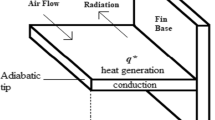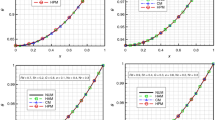Abstract
A collocation spectral method (CSM) is developed to solve the fin heat transfer in triangular, trapezoidal, exponential, concave parabolic, and convex geometries. In the thermal process of fin heat transfer, fin dissipates heat to environment by convection and radiation; internal heat generation, thermal conductivity, heat transfer coefficient, and surface emissivity are functions of temperature; ambient fluid temperature and radiative sink temperature are considered to be nonzero. The temperature in the fin is approximated by Chebyshev polynomials and spectral collocation points. Thus, the differential form of energy equation is transformed into the matrix form of algebraic equation. In order to test efficiency and accuracy of the developed method, five types of convective–radiative fins are examined. Results obtained by the CSM are assessed by comparing available results in references. These comparisons indicate that the CSM can be recommended as a good option to simulate and predict thermal performance of the convective–radiative fins.













Similar content being viewed by others
Abbreviations
- \(b_j\) :
-
Coefficient of the integral term weight
- \(C_i\) :
-
Dimensionless constants of the integral term weight
- \(\bar{{c}}_j\) :
-
Coefficient of Lagrange interpolation polynomials defined in Eq. 17
- \(c_i\) :
-
Constants of the integral term weight (\(\mathrm {W}{\cdot }\mathrm {m}^{-3}\))
- \(D_{i,j}^{\left( 1\right) }\) :
-
Entries of the first-order derivative matrix
- \(D_{i,j}^{\left( 2\right) }\) :
-
Entries of the second-order derivative matrix
- \(F_{i,j}\) :
-
Entries of spectral coefficient matrix which are defined in Eq. 20
- \(G_i\) :
-
Entries of spectral coefficient matrix which are defined in Eq. 21
- \(H_{i,j}\) :
-
Entries of spectral coefficient matrix which are defined in Eq. 24
- \(h_b\) :
-
Convective heat transfer coefficient corresponding to the temperature difference \(T_b -T_c\) (\(\mathrm {W}{\cdot } \mathrm {m}^{-2}{\cdot } \mathrm {K}^{-1}\))
- \(h_i\) :
-
Lagrange interpolation polynomials
- h :
-
Convective heat transfer coefficient (\(\mathrm {W}{\cdot } \mathrm {m}^{-2}{\cdot } \mathrm {K}^{-1}\))
- L :
-
Fin tip length (\(\mathrm {m}\))
- \(l_i\) :
-
Adjustment parameter
- m :
-
Power exponent of heat transfer coefficient
- \(N_{cc}\) :
-
Convective–conductive parameter
- \(N_{rc}\) :
-
Radiative–conductive parameter
- N :
-
Total number of collocation points
- \(P_i\) :
-
Entries of spectral coefficient matrix which are defined in Eq. 25
- \(\dot{q}\left( T\right) \) :
-
Internal heat generation (\(\mathrm {W}{\cdot } \mathrm {m}^{-3}\))
- \(q_c\) :
-
Convective heat loss (\(\mathrm {W}{\cdot } \mathrm {m}^{-1}\))
- \(q_r\) :
-
Radiative heat loss (\(\mathrm {W}{\cdot } \mathrm {m}^{-1}\))
- \(q_{\mathrm{total}}\) :
-
Total heat loss (\(\mathrm {W}{\cdot } \mathrm {m}^{-1}\))
- \(q_{\mathrm{ideal}}\) :
-
Ideal heat loss (\(\mathrm {W}{\cdot }\mathrm {m}^{-1}\))
- \(R_{\mathrm{Benchmark}}\) :
-
Benchmark results
- \(R_{\mathrm{CSM}}\) :
-
CSM results
- \(s_i\) :
-
CGL collocation points
- \(T_b\) :
-
Temperature at fin base (K)
- \(T_\mathrm{c}\) :
-
Ambient fluid temperature (K)
- \(T_s\) :
-
Radiation sink temperature (K)
- T :
-
Temperature (K)
- \(w_i\) :
-
Weight of integral term defined in Eq. 27
- X :
-
Dimensionless axial coordinate
- x :
-
Coordinate in x-direction (m)
- \(\alpha \) :
-
Coefficient of variable thermal conductivity
- \(\beta \) :
-
Coefficient of surface emissivity
- \(\gamma \) :
-
Dimensionless exponential power factor
- \(\delta \) :
-
Semi-thickness of the fin (m)
- \(\delta _0\) :
-
Semi-thickness at the fin tip (m)
- \(\delta _b\) :
-
Semi-thickness at the fin base (m)
- \(\varepsilon \) :
-
Surface emissivity
- \(\varepsilon _{\mathrm{error}}\) :
-
Integral averaged relative error
- \(\eta \) :
-
Fin efficiency
- \(\Theta ^{*}\) :
-
The last iterative value of dimensionless temperature
- \(\Theta _c\) :
-
Dimensionless ambient fluid temperature
- \(\Theta _s\) :
-
Dimensionless radiation sink temperature
- \(\Theta \) :
-
Dimensionless temperature
- \(\lambda _c\) :
-
Thermal conductivity at convection sink temperature (\(\mathrm {W}{\cdot } \mathrm {m}^{-1}{\cdot } \mathrm {K}^{-1}\))
- \(\lambda \) :
-
Thermal conductivity (\(\mathrm {W}{\cdot } \mathrm {m}^{-1}{\cdot } \mathrm {K}^{-1}\))
- \(\sigma \) :
-
Stefan–Boltzmann constant (\(\mathrm {W}{\cdot } \mathrm {m}^{-2}{\cdot } \mathrm {K}^{-4}\))
- i, j :
-
Solution node indexes
References
Y.A. Cengel, Heat Transfer: A Practical Approach (McGraw-Hill Science, London, 2007)
A.D. Kraus, A. Aziz, J.R. Welty, Extended Surface Heat Transfer (Wiley, New York, 2002)
T.L. Bergman, A.S. Lavine, F.P. Incropera, Introduction to Heat Transfer (Wiley, New York, 2011)
A.A. Sertkaya, S. Bilir, S. Kargicgimath, Experimental investigation of the effects of orientation angle on heat transfer performance of pin-finned surfaces in natural convection. Energy 36(3), 1513–1517 (2011)
J.R. Howell, R. Siegel, M.P. Menguc, Thermal Radiation Heat Transfer (CRC Press, New York, 2011)
A. Aziz, Perturbation solution for convective fin with internal heat generation and temperature dependent thermal conductivity. Int. J. Heat Mass Transf. 20(11), 1253–1255 (1977)
A. Razani, G. Ahmadi, On optimization of circular fins with heat generation. J. Frankl. Inst. 303(2), 211–218 (1977)
A. Aziz, M.N. Bouaziz, A least squares method for a longitudinal fin with temperature dependent internal heat generation and thermal conductivity. Energy Convers. Manag. 52(8–9), 2876–2882 (2011)
S.E. Ghasemi, M. Hatami, D.D. Ganjj, Thermal analysis of convective fin with temperature-dependent thermal conductivity and heat generation. Case Stud. Therm. Eng. 4, 1–8 (2014)
B. Kundu, K.S. Lee, A non-Fourier analysis for transmitting heat in fins with internal heat generation. Int. J. Heat Mass Transf. 64, 1153–1162 (2013)
A. Aziz, T. Fang, Alternative solutions for longitudinal fins of rectangular, trapezoidal, and concave parabolic profiles. Energy Convers. Manag. 51(11), 2188–2194 (2010)
M. Torabi, A. Aziz, Thermal performance and efficiency of convective–radiative T-shaped fins with temperature dependent thermal conductivity, heat transfer coefficient and surface emissivity. Int. Commun. Heat Mass Transf. 39(8), 1018–1029 (2012)
C. Arslanturk, Performance analysis and optimization of radiating fins with a step change in thickness and variable thermal conductivity by homotopy perturbation method. Heat Mass Transf. 47(2), 131–138 (2011)
M. Torabi, A. Aziz, K.L. Zhang, A comparative study of longitudinal fins of rectangular, trapezoidal and concave parabolic profiles with multiple nonlinearities. Energy 51, 243–256 (2013)
S. Saedodin, M.S.M. Barforoush, Comprehensive analytical study for convective–radiative continuously moving plates with multiple non-linearities. Energy Convers. Manag. 81, 160–168 (2014)
J.S. Hesthaven, E.M. Ronquist, Spectral and High Order Methods for Partial Differential Equations (Springer, Heidelberg, 2010)
J. Shen, T. Tang, L.L. Wang, Spectral Methods: Algorithms, Analysis and Applications (Springer, London, 2011)
C. Canuto, M.Y. Hussaini, A. Quarteroni, T.A. Zang, Spectral Methods: Fundamentals in Single Domains (Springer, Berlin, 2006)
A. Karageorghis, T.N. Phillips, Chebyshev spectral collocation methods for laminar flow through a channel contraction. J. Comput. Phys. 84(1), 114–113 (1989)
B.W. Li, Y.R. Zhao, Y. Yu, Z.D. Qian, Three-dimensional transient Navier–Stokes solvers in cylindrical coordinate system based on a spectral collocation method using explicit treatment of the pressure. Int. J. Numer. Methods Fluids 66(3), 284–298 (2011)
M. Najafi, K. Hejranfar, V. Esfahanian, Application of a shock-fitted spectral collocation method for computing transient high-speed inviscid flows over a blunt nose. J. Comput. Phys. 257, 954–980 (2014)
F.H. Zeng, H.P. Ma, D. Liang, Energy-conserved splitting spectral methods for two dimensional Maxwell’s equations. J. Comput. Appl. Math. 265(1), 301–321 (2014)
Y. Yu, B.W. Li, A. Thess, The effect of a uniform magnetic field on vortex breakdown in a cylinder with rotating upper lid. Comput. Fluids 88, 510–523 (2013)
S. Abbasbandy, T. Hayat, H.R. Ghehsareh, A. Alsaedi, MHD Falkner–Skan flow of Maxwell fluid by rational Chebyshev collocation method. Appl. Math. Mech. 34(8), 921–930 (2013)
J. Ma, B.W. Li, J.R. Howell, Thermal radiation heat transfer in one- and two-dimensional enclosures using the spectral collocation method with full spectrum k-distribution model. Int. J. Heat Mass Transf. 71, 35–43 (2014)
J. Ma, Y.S. Sun, B.W. Li, Analysis of radiative transfer in a one-dimensional nonlinear anisotropic scattering medium with space-dependent scattering coefficient using spectral collocation method. Int. J. Heat Mass Transf. 67, 569–574 (2013)
Y.S. Sun, J. Ma, B.W. Li, Chebyshev collocation spectral method for three-dimensional transient coupled radiative–conductive heat transfer. ASME J. Heat Transf. 134(9), 092701 (2012)
F. Khani, M.A. Raji, H.H. Nejad, Analytical solutions and efficiency of the nonlinear fin problem with temperature-dependent thermal conductivity and heat transfer coefficient. Commun. Nonlinear Sci. Numer. Simul. 14(8), 3327–3338 (2009)
O. Madelung, G.K. White, Thermal Conductivity of Pure Metals and Alloys (Springer, Berlin, 1991)
M. Torabi, Q.B. Zhang, Analytical solution for evaluating the thermal performance and efficiency of convective–radiative straight fins with various profiles and considering all non-linearities. Energy Convers. Manag. 66, 199–210 (2013)
Acknowledgments
This work was supported by the Natural Science Foundation of China (Nos. 51206043, 51406014, 51176026), and the Specialized Research Fund for the Doctoral Program of Higher Education (No. 20130036120009), and the Fundamental Research Funds for the Central Universities (Nos. 310822151021, 2015MS42).
Author information
Authors and Affiliations
Corresponding authors
Ethics declarations
Conflicts of interest
The authors declare that there is no conflict of interests regarding the publication of this article.
Rights and permissions
About this article
Cite this article
Sun, YS., Ma, J. & Li, BW. Application of Collocation Spectral Method for Irregular Convective–Radiative Fins with Temperature-Dependent Internal Heat Generation and Thermal Properties. Int J Thermophys 36, 3133–3152 (2015). https://doi.org/10.1007/s10765-015-1978-0
Received:
Accepted:
Published:
Issue Date:
DOI: https://doi.org/10.1007/s10765-015-1978-0




